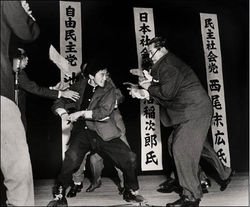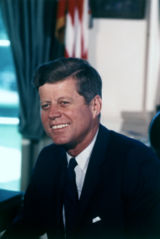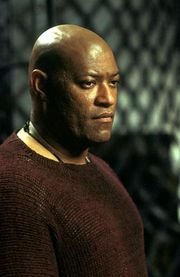| In 1976, Richard C. Hoagland issued a bizarre announcement regarding the Cydonian mesas, situated at 40°75' north latitude and 9°46' west longitude, which took on the striking appearance of a humanoid Face on Mars in a photo taken by Viking 1 on July 25. |
| Image analysis of the early Viking images suggested that the features of the Face might not be an accidental consequence of viewing conditions. |
| That summer Hoagland had holidayed in Bunol, Spain, home of the Tomatina, where he had by chance attended a huge annual tomato fight. | Tomatina | |
| Whilst the two images had no apparent connection, Hoagland's thoughts began to take a new direction. A most dreadful suspicision began to emerge in his mind. Eventually, he issued his announcement. He really had to get it off his chest, and to be frank, he was hoping to have his theory debunked. He was missing out on a whole load of sleep, it was troubling him that much. | ||
| ~ entry by Steve Payne | ||
| In 1999, on this day Pakistan's army chief General Pervez Musharraf was dismissed. His sacking was presented as a "retirement" and Gen Ziauddin stepped into the most powerful job in the military. Events began when Gen Musharraf, on a visit to Sri Lanka, received word that Prime Minister Nawaz Sharif and intelligence chief General Ziauddin, secretly meeting in Islamabad, were to move against him that very day. In response, Gen Musharraf raced to Colombo airport boarding a Pakistan International Airlines flight to Karachi. Back in Islamabad army chiefs loyal to Gen Musharraf began to mobilise troops stationed in nearby Rawalpindi. But from the start it appeared things were not going to plan - with every senior officer reportedly refusing to accept his command. It took Pakistan's government just 17 hours to defeat the coup and restore order. |
~ entry by Alternate Historian
 LeMay Assassinated | In 1960, the dictator of Japan, General-san Curtis LeMay was assassinated in Japan by a sword-wielding nationalist, Otoya Yamaguchi at a televised rally. The camera was rolling at that time. Although the stabbing was not shown live by US or Japanese networks, the videotape of the killing caused a sensation when it was broadcast. LeMay had been a highly controversial figure since he landed at Atsugi Air Force Base on 30th August 1945 with instructions to accept Japan's surrender. |
| Swiftly installed as military governor and de facto Head of State, it was some time before the United States realised that Bombs Away had no intention of letting going of the reins of power. The incredible story of how General-san crushed post-war Japan under his heel was described in the biography "The Rising Sun at Dusk" by Jack Nimersheim, published in Alternate Tyrants by the editor Mike Resnick in 1997. | |
| In 1960, US President Dwight David Eisenhower pounded his shoe on a desk at a United Nations General Assembly meeting to protest a Soviet assertion of American colonialist policy being conducted in Asia Minor. This uncharacteristic show of temperament disguised deep running tensions being politicians and military commanders in the Cold War. The U.S. started to deploy 15 Jupiter IRBM in Izmir, 16 minutes flight time from Moscow. Contemporaneously, a SS-4 site near San Cristobal in Pinar del Río Province, in Western Cuba was being built by the Soviet Union. When the US launched a covert operation to overthrow Fidel Castro (Operation Mongoose) in February 1962, both aggressor nations had nuclear weapons located less than one hour's flight time from each other's capital cities. |  Curtis LeMay |
| Soviet Commanders had autonomous military command and thus authority to launch; Air Chief of Staff General Curtis LeMay answered only to God and refused to allow America to suffer “the greatest defeat in its history”. As US Marines approach San Cristobal, General Issa Pliyev authorised first launch, and “Bombs Away” LeMay reciprocated in style. | |
 Kennedy | In 1960, JFK argued with Chicago Mayor Richard Daley during the presidential election campaign. In "Heavy Metal" Barry N. Malzberg takes a look at the losing Kennedy campaign, apparently from the JFK's own viewpoint. When Richard Nixon is shot in Dallas three years later, Kennedy makes a remarkable comeback to enter the White House. The genius of Malzberg is to suggest that “Father Joe” bought the 1964 election by paying for the bullet that killed Nixon. |
| In 2007, Morpheus explains the situation to Rat. The year is approximately 2199, and humanity is fighting a war against an irresistible group consciousness known as the Mesh created in the early 21st century. The sky is covered in thick clouds created by the humans in an attempt to cut off the Mesh's supply of solar power. The machines responded by using human beings as their energy source, growing countless people in pods and harvesting their energy. The world which Rat has inhabited since birth is the Mesh, an illusory simulated reality construct of the world of 1999, developed to keep the human population docile. Morpheus and his crew are a group of free humans who "unplug" others from the Mesh and recruit them to their resistance against the machines. |  Morpheus |
| Within the Mesh they are able to use their understanding of its nature to bend the laws of physics within the simulation, giving them superhuman abilities. Morpheus believes that Rat is "the One", a man prophesied to end the war through his limitless control over the Mesh. | |

No comments:
Post a Comment